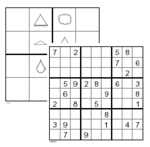
Worksheets and No Prep Teaching Resources
Reading Comprehension Worksheets
 Worksheets and No Prep Teaching Resources Reading Comprehension Worksheets |
|
| edHelper's suggested reading level: | grades 5 to 7 | |
| Flesch-Kincaid grade level: | 6.19 |
|
Sudoku History
By Vickie Chao |

|
 1 Do you like to play crossword puzzles but find it frustrating to fill in all the words? Do you like to give your brain a mental workout? If this is the case, you may want to check out the sudoku (pronounced "sue-do-koo") puzzle.
1 Do you like to play crossword puzzles but find it frustrating to fill in all the words? Do you like to give your brain a mental workout? If this is the case, you may want to check out the sudoku (pronounced "sue-do-koo") puzzle. |
Create Weekly Reading Books
Prepare for an entire week at once! |
| Leave your feedback on Sudoku History (use this link if you found an error in the story) |
 |
Make and Print Free SUDOKU Puzzles | edHelper.com
|